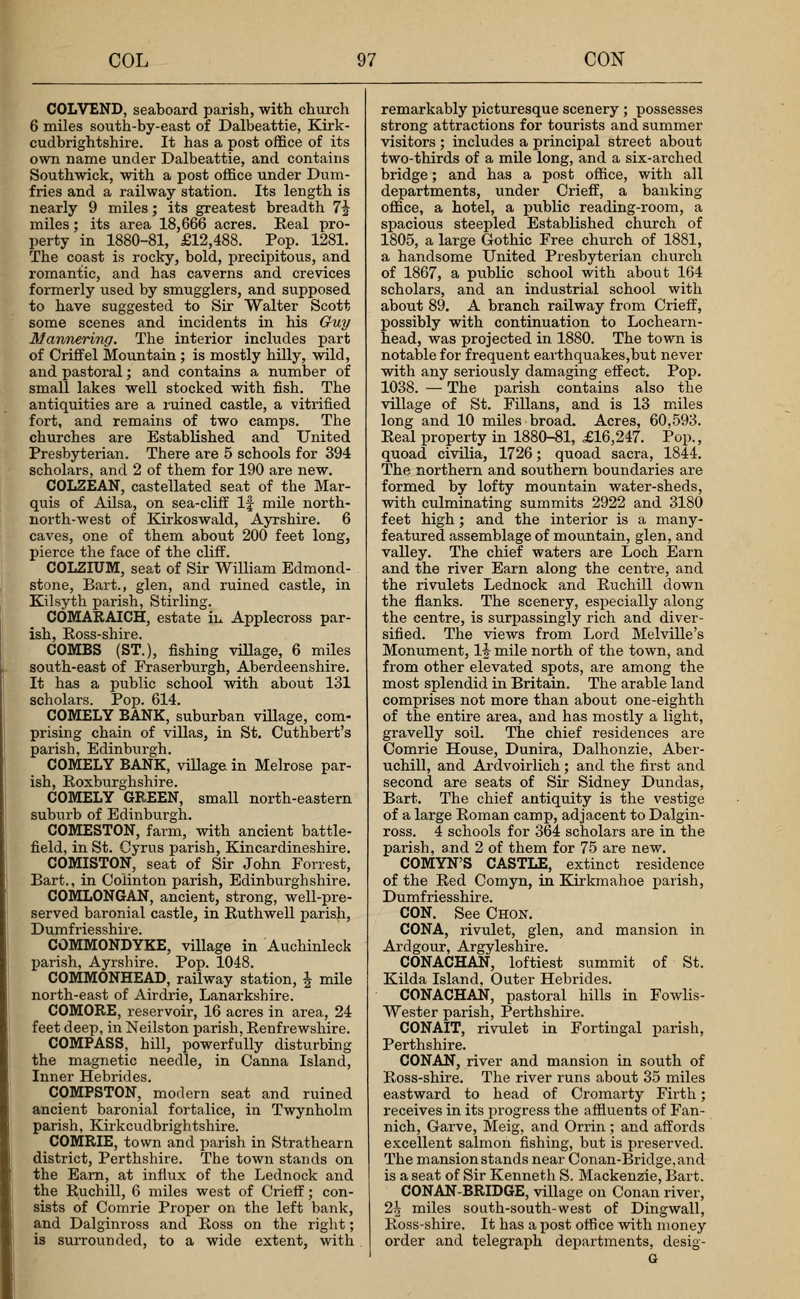COLVEND, seaboard parish, with church 6 miles south-by-east of Dalbeattie, Kirkcudbrightshire. It has a post office of its own name under Dalbeattie, and contains Southwick, with a post office under Dumfries and a railway station. Its length is nearly 9 miles ; its greatest breadth 7^ miles ; its area 18,666 acres. Eeal property in 1880-81, 12,488. Pop. 1281. The coast is rocky, bold, precipitous, and romantic, and has caverns and crevices formerly used by smugglers, and supposed to have suggested to Sir Walter Scott some scenes and incidents in his Guy Mannering. The interior includes part of Criffel Mountain ; is mostly hilly, wild, and pastoral ; and contains a number of small lakes well stocked with fish. The antiquities are a ruined castle, a vitrified fort, and remains of two camps. The churches are Established and United Presbyterian. There are 5 schools for 394 scholars, and 2 of them for 190 are new.
COLZEAN, castellated seat of the Marquis of Ailsa, on sea-cliff If mile north-north-west of Kirkoswald, Ayrshire. 6 caves, one of them about 200 feet long, pierce the face of the cliff.
COLZIUM, seat of Sir William Edmond-stone, Bart., glen, and ruined castle, in Kilsyth parish, Stirling.
COMARAICH, estate in Applecross parish, Boss-shire.
COMBS (ST.), fishing village, 6 miles south-east of Fraserburgh, Aberdeenshire. It has a public school with about 131 scholars. Pop. 614.
COMELY BANK, suburban village, com-prising chain of villas, in St. Cuthbert's parish, Edinburgh.
COMELY BANK, village in Melrose parish, Roxburghshire.
COMELY GREEN, small north-eastern suburb of Edinburgh.
COMESTON, farm, with ancient battle-field, in St. Cyrus parish, Kincardineshire.
COMISTON, seat of Sir John Forrest, Bart., in Colinton parish, Edinburghshire.
COMLONGAN, ancient, strong, well-preserved baronial castle, in Ruthwell parish, Dumfriesshire.
COMMONDYKE, village in Auchinleck parish, Ayrshire. Pop. 1048.
COMMONHEAD, railway station, | mile north-east of Airdrie, Lanarkshire.
COMORE, reservoir, 16 acres in area, 24 feet deep, in Neilston parish, Renfrewshire.
COMPASS, hill, powerfully disturbing the magnetic needle, in Canna Island, Inner Hebrides.
COMPSTON, modern seat and ruined ancient baronial fortalice, in Twynholm parish, Kirkcudbrightshire.
COMRIE, town and parish in Strathearn district, Perthshire. The town stands on the Earn, at influx of the Lednock and the Ruchill, 6 miles west of Crieff ; consists of Comrie Proper on the left bank, and Dalginross and Ross on the right ; is surrounded, to a wide extent, with remarkably picturesque scenery ; possesses strong attractions for tourists and summer visitors ; includes a principal street about two-thirds of a mile long, and a six-arched bridge ; and has a post office, with all departments, under Crieff, a banking office, a hotel, a public reading-room, a spacious steepled Established church of 1805, a large Gothic Free church of 1881, a handsome United Presbyterian church of 1867, a public school with about 164 scholars, and an industrial school with about 89. A branch railway from Crieff, possibly with continuation to Lochearnhead, was projected in 1880. The town is notable for frequent earthquakes,but never with any seriously damaging effect. Pop. 1038. The parish contains also the village of St. Fillans, and is 13 miles long and 10 miles broad. Acres, 60,593. Real property in 1880-31, 16,247. Pop., quoad civilia, 1726 ; quoad sacra, 1844. The northern and southern boundaries are formed by lofty mountain water-sheds, with culminating summits 2922 and 3180 feet high ; and the interior is a many-featured assemblage of mountain, glen, and valley. The chief waters are Loch Earn and the river Earn along the centre, and the rivulets Lednock and Ruchill down the flanks. The scenery, especially along the centre, is surpassingly rich and diversified. The views from Lord Melville's Monument, 1 mile north of the town, and from other elevated spots, are among the most splendid in Britain. The arable land comprises not more than about one-eighth of the entire area, and has mostly a light, gravelly soil. The chief residences are Comrie House, Dunira, Dalhonzie, Aberuchill, and Ardvoirlich ; and the first and second are seats of Sir Sidney Dundas, Bart. The chief antiquity is the vestige of a large Roman camp, adjacent to Dalginross. 4 schools for 364 scholars are in the parish, and 2 of them for 75 are new.
COMYN'S CASTLE, extinct residence of the Red Comyn, in Kirkmahoe parish, Dumfriesshire.
CON.
CON A, rivulet, glen, and mansion in Ardgour, Argyleshire.
CONACHAN, loftiest summit of St. Kilda Island, Outer Hebrides.
CONACHAN, pastoral hills in Fowlis-Wester parish, Perthshire.
CONAIT, rivulet in Fortingal parish, Perthshire.
CONAN, river and mansion in south of Ross-shire. The river runs about 35 miles eastward to head of Cromarty Firth ; receives in its progress the affluents of Fannich, Garve, Meig, and Orrin ; and affords excellent salmon fishing, but is preserved. The mansion stands near Conan-Bridge,and is a seat of Sir Kenneth S. Mackenzie, Bart.
CONAN-BRIDGE, village on Conan river, 2^r miles south-south-west of Dingwall, R~bss-shire. It has a post office with money order and telegraph departments, designated of Ross-shire, a railway station, a good inn, a live-arched bridge, and a public school with about 112 scholars. Pop. 385.

